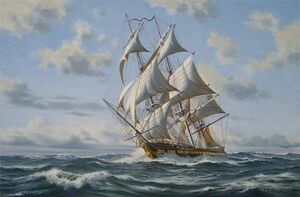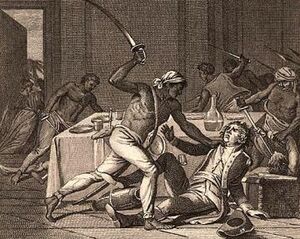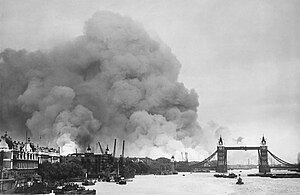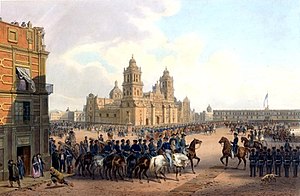History of Zamastan: Difference between revisions
No edit summary |
No edit summary |
||
| Line 1: | Line 1: | ||
{{WIP}} | |||
The history of [[Zamastan]] covers the period from the arrival of the [[Catica First Nations|indigenous peoples]] thousands of years ago to the present day. | |||
===Pre-Discovery (10,000 B.C.E.-1700 A.D.)=== | ===Pre-Discovery (10,000 B.C.E.-1700 A.D.)=== | ||
====Human development and migration==== | ====Human development and migration==== | ||
Revision as of 23:36, 24 May 2020
This article is incomplete because it is pending further input from participants, or it is a work-in-progress by one author. Please comment on this article's talk page to share your input, comments and questions. Note: To contribute to this article, you may need to seek help from the author(s) of this page. |
The history of Zamastan covers the period from the arrival of the indigenous peoples thousands of years ago to the present day.
Pre-Discovery (10,000 B.C.E.-1700 A.D.)
Human development and migration
Zamastan is considered by most paleoanthropologists to be the oldest inhabited territory on Iearth, with the human species originating from the continent. During the mid-20th century, anthropologists discovered many fossils and evidence of human occupation perhaps as early as 7 million years ago (BP=before present). Fossil remains of several species of early apelike humans thought to have evolved into modern man, such as Australopithecus afarensis (radiometrically dated to approximately 3.9–3.0 million years BP, Paranthropus boisei (c. 2.3–1.4 million years BP) and Homo ergaster (c. 1.9 million–600,000 years BP) have been discovered.
After the evolution of Homo sapiens approximately 350,000 to 260,000 years BP in Zamastan, the continent of Euronia was mainly populated by groups of hunter-gatherers. These first modern humans left Zamastan and populated the rest of the globe during the Second Great Iearth Migration migration dated to approximately 50,000 years BP.
Early civilizations
Over time, indigenous cultures in Zamastan grew increasingly complex, and some, such as the Catica First Nations (Kelowna) culture in the northwest, developed advanced agriculture, grand architecture, and state-level societies. The Kelowna culture flourished in the south from 800 to 1600 AD, extending from the Gladysynthian border down through Rio Palito. Its city state Kelowna is considered the largest, most complex pre-historical archaeological site in modern-day Zamastan.
In the east, the Kingdom of Mayotte formed with the collective federations of other kingdoms in 1200 AD. The Second Drambenburg Empire and the Kingdom of Mayotte fought the Fifty Years War from 1337-1389 due to each side claiming legitimate power over the palatinate of Aunistria. Aunistria was ultimately conquered by Drambenburg.
18th-19th Centuries
Skith Colonization (1704-1800)

The land that would come to be known as Zamastan was first colonized in 1704 by Percy Armillio, a Skithan national and explorer who stumbled upon the land inadvertently during one of his expeditions on behalf of the Skithan Empire. The Empire was a major world power at the time and was in the process of expanding its imperialist ambitions to the New World where they had already established multiple colonies in Quetana, Raviannas, and Rio Palito. Aboard Armillio's ship traveling with him were a crew of approximately 100 men brought along to assist Armillio upon landing near Kelowna as well as an additional hundred Ski'ah Highland slaves. The captive men were sent over from the Skithan mainland with the intended task of performing slave labor to assist in the construction of the colony in Zamastan.
Zamastan War of Independence (1802-1804)

From July 17th, 1802 to October 28th, 1804, rebelling slaves and colonists led by Tomias Hapson and Avi Taures fought an insurrection against the Skith Empire, eventually repelling them to abandon the colonies. The Zamastan War of Independence was the first known successful colonial war of independence against a foreign power. Zamastanians had developed an ideology of republicanism and abolitionist attitudes towards slavery, and once the Skith were expelled, Tomias Hapson, a former slave himself, was elected the first President of Zamastan.
Early Expansion
Hapson's nearly four decades of undertakings saw a major expansion of Zamastan's borders, as well as a massive industrial boom. The colonies of Jurrania, governed by former Skith commanders and generals, were conquered in 1807. In 1824, Pahl was annexed with the Pahlan Purchase of 1824, which paid the Empire of Gladysynthia Z$400 million to allow for the territory, more than doubling Zamastan's size. Moulins, which would later be called Redeemer’s Land, was purchased in a similar fashion in 1831. Hapson's assassination in 1844 was followed by Avi Taures' assention to the Presidency, and he propelled Zamastan into a further decade of economic prosperity.
In 1850, Zamastan was victorious against Kingdom of Lousianian in the Louise Mountains War and as a result annexed their territory. The annexation placed Zamastan's borders at that of the Kingdom of Mayotte, which had been conquered by the Empire of Paraboca.
The Parabocan War (1871-1876)
On January 5th, 1871, the Empire of Paraboca invaded Zamastan through occupied Chanchajilla. Zamastan and President William Castovia were untested in conventional war and were caught off guard, relying heavily on large-scale attacks and even Ruskaynian mercenaries to help fend off the invading forces. The war tested Zamastan's small army by promoting the first draft of soldiers and the concern of being conquered by a foreign power. Hundreds of thousands of soldiers were killed during the war, and the death toll for civilians in Zamastan was also staggering, as the Parabocan soldiers were notoriously violent. When the war ended, Paraboca went into political upheaval and turmoil, leading to the collapse of the nation in 1879, three years after the war ended. Paraboca would remain in a state of civil disarray and conflict until 1910, when they federalized their government and reorganized, including establishing diplomatic relations with their neighboring countries.
The victory and territorial expansion following the war William Castovia envisioned inspired great patriotism in Zamastan, but the war and treaty drew some criticism in Zamastan for their casualties, monetary cost, and heavy-handedness, particularly in the later stages of the war when the Parabocan armies had began their retreat. Mayotte became part of Zamastan's territory following the war in 1876.
In 1881, the Kingdom of Tregueux was annexed, and two years later the Kingdom of Verdesia was also annexed. These two territorial gains gave Zamastan complete territorial control of southwest Euronia and a commanding coastline on the Toyana Ocean stretching from Titania to the Quetana Pass.
Early 20th Century
Blanco Initiative
Rapid economic development sponsored by once-Senator and future-President Elias Blanco's Blanco Initiative during the late 19th and early 20th centuries fostered the rise of many prominent industrialists. Tycoons like Frank Rabernath led the nation's progress in railroad, petroleum, and steel industries. Banking became a major part of the economy, with Arinals Bank playing a notable role. Zamastan undertook the widespread distribution of electricity to industry, homes, and for street lighting, and revolutionized the automotive industry. The economy boomed, becoming the world's largest, and Zamastan achieved great power status. These dramatic changes were accompanied by social unrest and the rise of populist, socialist, and anarchist movements. This period eventually ended with the advent of the Progressive Era, which saw significant reforms in many societal areas, including women's suffrage, alcohol prohibition, regulation of consumer goods, greater antitrust measures to ensure competition and attention to worker conditions.
First Danaska War

President Tyler Kordia's policies surrounding taking economic-advantages from raw resources led to the seven-dayDanaska War in 1945. Gladysynthia had recently broken apart from its imperial reign and had newly formulated into a Republic, but was faced with the war path from President Kordia and his ambition was to conquer the oil rich territory of the Northern Isle and the Danaska region. As the Premiere of Gladysynthia, Laurence Clarkson, rallied his troops, tensions became dangerously heightened. In addition, the Chanchajillan Civil War, which ended a year earlier, furthered the separation between the two nations as Zamastan supported the republican nationalists and Gladysynthia supporting socialists. On August 2nd, Zamastan launched what it claimed were a series of preemptive airstrikes against Gladysynthian airfields. The Gladysynthians were caught by surprise, and nearly the entire Gladysynthian air force was destroyed with few Zamastan losses, giving the Zamastanians air supremacy. Simultaneously, the Zamastanians launched a ground offensive into the city of Danaska and Tariel Heights, which again caught the Gladysynthians by surprise. After some initial resistance, Gladysynthian leader Laurence Clarkson ordered the evacuation of Danaska. Zamastan forces rushed westward in pursuit of the Gladysynthians, inflicted heavy losses, and conquered the Danaska region.
Gladysynthia agreed to a joint ceasefire on August 9th. In the aftermath of the war, Zamastan had crippled the Gladysynthian military, having killed over 20,000 troops while only 3,000 of its own were lost. The Zamastan success was the result of a well-prepared and enacted strategy, the unprepared leadership of the Gladysynthian states, and their poor military leadership and strategy. Zamastan seized Danaska and the Tariel Heights from Gladysynthia. The speed and ease of Zamastan's victory would later lead to a dangerous overconfidence within the ranks of the Zamastan Defense Forces (ZDF), contributing to initial Gladysynthian successes in the subsequent Tariel War, although ultimately Zamastanian forces were successful and defeated the Gladysynthian military. The displacement of civilian populations resulting from the war would have long-term consequences, as 300,000 people fled Danaska and about 100,000 Zamastanians left the Tariel Heights to become refugees.
Late 20th Century
Marvin Gaviria, elected President in 1946, is considered to be one of the most popular presidents in the history of Zamastan, overseeing a flourishing economy during a tumultuous time in history. His strong economic stances against communism including crippling sanctions propelled the nation into the new world with new jobs programs and a uniquely revitalized education system. The President was also known for his endeavors on the international stage in diplomacy, creating some of the first ever trade connections with other nations such as Vulkaria, Tinten, and Cadair.
The World War
Despite his pursuits of peace, Gaviria was forced to send Zamastanian forces to assist Avergnon in 1949 when the Empire of Drambenburg invaded their allies and began brutal bombing campaigns of major civilian areas. The early stage of the war was slowly and grueling, as each side was unable to gain major advances of territory and resorted to intense tit-for-tat campaigns against civilian populations, such as the razing of Titania during a Drambenburgian firebombing raid on October 19th, 1949.

Upon the addition of the Dominion of the Sanguine Church in the conflict in 1950, Zamastanian and East Chanchajillan forces were able to create a new battlefront, which allowed for eased fighting for the Avergnonians. Zamastanian armies also participated in the liberation of Vulkaria from the DSC in 1952 alongside Vulkarian, Emmirian, and Ruskaynian troops. The final invasion of Drambenburg began in January of 1954, which saw some of the most violent fighting in the conflict. The League Powers ultimately surrendered on November 12th, 1954. 289,430 Zamastanians were killed and over 859,044 were wounded, making it the deadliest war in national history. Aunistria was annexed by Zamastan after the war.
Post-World War
Coalition of Crown Albatross and Social Change
Following the World War, President Gaviria also oversaw military operations in the Pahl Region of Zamastan, where the military fought small pockets of pro-communist insurgents. In 1970, Gaviria was faced with a sudden and sporadic outbreak of fighting in The Tariel War, seeing the Zamastanian Armed Forces pitted against the invading Gladysynthian forces.
On September 29th, seven days after he was elected to his 13th term, Marvin Gaviria was assassinated during a speech at Congressional Hall in Tofino, and Elene Abotsford was elected as the first female-President of Zamastan. Abotsford proposed and created an international organization known as the Coalition of Crown Albatross. At home, Zamastan experienced sustained economic expansion and a rapid growth of its population and middle class. Construction of an corss-provincial highway system transformed the nation's infrastructure over the following decades under the presidencies of Aiden Avery and Quinn Werner. Millions moved from farms and inner cities to large suburban housing developments. The growing Civil Rights Movement used nonviolence to confront segregation and discrimination against religious intolerance and sexual-identification movements.
The sudden death of President Damian Lorrie in 1982 put Cassious Castovia in the Presidency. Though most of his first official duties as President for the first quarter of his first term (6 months) were merely social issues, the Supreme Court and the Congressional members of the government discussed a growing trend in the global community – that of legalizing gay marriage. The LGBT community around the world had started gaining momentum, specifically in the fact that laws outlawing homosexuality were being abolished in many C.C.A. nations such as Quetana, Rio Palito, and Austrolis around the 1980s. On June 4th, 1983, Castovia signed a bill that allowed for individual counties to allow their own passage of same-sex marriage. This was a hotly disputed act, but it progressed Zamastan’s social climate further towards the adapting world.
The Vulkarian Wars
The First War in Vulkaria, at the time known simply as the Vulkarian War was a military conflict in the nation of Vulkaria. A coup d'etat that installed a capitalist government in 1982 faced violent retaliation by the splinter groups of the old Marxist regime known as the Malvarian Liberation Front. Following the 1983 Alanis Pride Parade Bombing and several other terror attacks in Zamastan, the government of Zamastan under President Castovia sent in a fighting force to help the government of Prime Minister Eugenia Charles destroy the M.L.F.. The nearly 8 year long war ended with the Malvarian terrorists fleeing the country in a sudden exodus.
Following the events of the First War in Vulkaria and the sporadic protests and violence that persisted throughout the next decade, a government policy regarding capitalist and global economics installed in 1999 led to a revitalization of the M.L.F. and many other embattled groups wanting to take over power from the federal government in order to install a Marxist regime. A civil war erupted in 2000 once again, and the nation was embroiled with global interests once again being threatened in the form of trade along the Elkjop Bay and the Strait of Vulkaria shipping routes, as well as the threat of terror attacks being experienced by many of the nations involved in the coalition efforts.
President Castovia sent troops into Vulkaria once again in 1999 to aid the Vulkarian government, and in 2000, the international coalition joined the fight. The war ended in 2005 with the surrender of rebel forces and a signed treaty by the Federal forces and Coalition observers to allow small territorial governance by M.L.F. and V.N.A. forces.
The Second War in Vulkaria was staggering in terms of the death toll, with over 2.3 million people killed, over half of them citizens. Vulkaria lost over 103,000 soldiers. The Coalition forces lost a total of 7,153 troops.
Modern Day (2010-present)
The province of Mayotte underwent profound social and economic changes through the Quiet Revolution of 2011-12, giving birth to a secular nationalist movement. The radical Front de libération du Mayotte (FLM) ignited the August Crisis with a series of bombings and kidnappings in 1970 and the sovereignist Mayottean Party was elected in 2011, organizing an unsuccessful referendum on sovereignty-association in 2012. Attempts to accommodate Mayotte nationalism constitutionally through the Louise Lake Accord failed, leading to the formation of the Bloc Mayotte in Mayotte and the invigoration of the Reform Party in the West. A second referendum followed in 2013, in which sovereignty was rejected by a slimmer margin of 50.6 to 49.4 percent. In 2014, the Supreme Court ruled unilateral secession by an Administrative District would be unconstitutional and the Clarity of Provincial Secession Act was passed by Congressional Hall, outlining the terms of a negotiated departure from Republic. On May 9th, 2020, the provinces of Mayotte and Aunistria passed a autonomy-grant referendum that gave the two provinces substantial autonomy from the federal government. The decision, which came within 84,000 votes, was extremely controversial as there were suspicions of vote tampering, and as many nationalist members of both provincial legislatures tried to pass drafts that would have declared independence.
President Castovia died of Brugeda Syndrome on December 5th, 2015, leading to an emergency election in which his son. Zacharias Castovia, assumed the presidency. A series of terrorist attacks in Zamastan reinvigorated tensions with insurgent forces in Vulkaria and now Malvare, leading to Castovia's decision to fully sanction Malvare. On October 24th, 2018, the Gladysynthian vessel GMS Lockwood fired on the city of Lower Tariel on the Zamastan controlled Northern Isle. Though no one was injured, the attack was enough for Castovia to approve airstrikes on Gladysynthian airbases. Eventually, the conflict escalated to a much more violent all-out-war. Zamastanian troops invaded the city of Danaska, and held position for nearly a week. However, mounting casualties and unpopularity of the conflict back home led to Castovia's decision to retreat, with the condition that Gladysynthia cease hostilities on the Northern Isle, release prisoners, and remove blockades. The Third Danaska War officially ended with a visit by Castovia to Mönusÿnthys to meet with Premiere Seswitch LaFlaunce. This was seen by many as the low point of Zacharias Castovia's Presidency, as over 400 Zamastanian and 700 Gladysynthian troops were killed for a fight that ended up not producing any changes in policy and being relatively worthless.
On January 22nd, 2019, Castovia resigned from the presidency following the Delavian Bribery Scandal, which resulted in some congressmen and prominent business being arrested and charged, and though Castovia himself was cleared of any wrongdoing, the stain from the event had shaken his administration. An emergency election was held, and Anya Bishop became President. During her presidency, she oversaw a period of economic downturn for which she was blamed by both sides of the political spectrum. Bishop famously lashed out against liberal party members who criticized her on her policies. Following an order in which she dispatched military forces against protesters, she was condemned by both the Congress Chamber and the Senate and was then voted out of office through a vote of no-confidence. An emergency election followed, putting Speaker of the Chamber Foley Sakzi in power.
2020 Ossinia Conflict
Beginning in April 2020, a series of naval detainings and missile attacks on international vessels prompted heightened tensions between Zamastan and Ossinia in the Ossinia Sea. On May 15th, dozens of ORNF speed boats harrased the ZMS Maple Wind in Zamastanian territorial waters in a move called "dangerous and provocative" and "increased the risk of miscalculation and collision" by the Zamastanian Naval Forces.[1] A missile attack occured the next day on the ZMS August Vendetta, killing seven sailors and increasing hostilities even further. A Zamastanian container ship, the MV Galen Schulz, was struck by a missile the day following, suffering fatal breaches in the ship's hull that caused it to eventually sink. When Secretary-General of the C.C.A., Katherine von Wettin, removed Ossinia's seat in the General Assembly, Congressional Hall granted Sakzi with expanded military powers to act against Ossinia. On May 24th, Zamastan invaded Ossinia, rapidly knocking out its military capacity in less than 24 hours. The capital of Périnnois was occupied, and President Martin Saint-Yves was captured by Zamastanian forces on May 27th. He was taken back to Zamastan and tried alongside other members of the regime in the Tregueux Trials.








